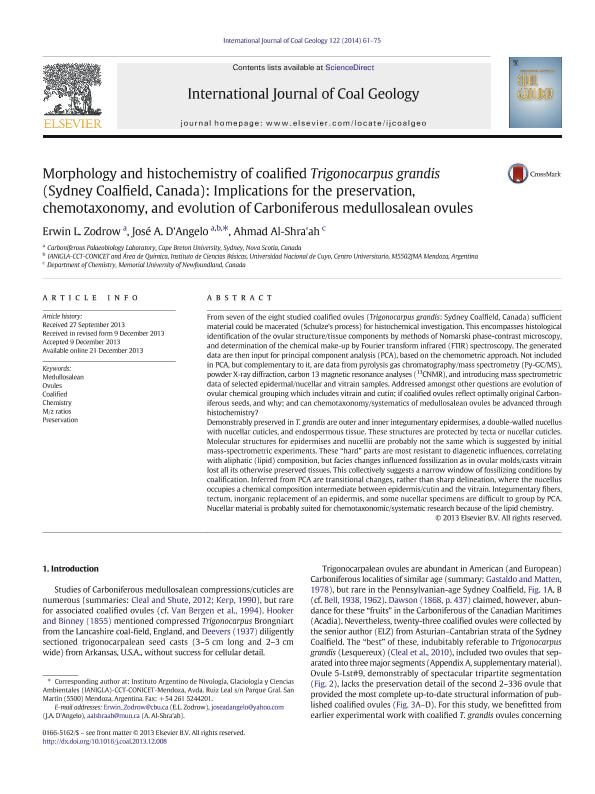Mostrar el registro sencillo del ítem
dc.contributor.author
Zodrow, Erwin L.
dc.contributor.author
D`angelo, José Alejandro

dc.contributor.author
Al-Shraah, Ahmad
dc.date.available
2017-10-02T13:37:56Z
dc.date.issued
2013-12-13
dc.identifier.citation
Zodrow, Erwin L.; D`angelo, José Alejandro; Al-Shraah, Ahmad; Morphology and histochemistry of coalified Trigonocarpus grandis (Sydney Coalfield, Canada): Implications for the preservation, chemotaxonomy, and evolution of Carboniferous medullosalean ovules; Elsevier Science; International Journal Of Coal Geology; 122; 13-12-2013; 61-75
dc.identifier.issn
0166-5162
dc.identifier.uri
http://hdl.handle.net/11336/25535
dc.description.abstract
From seven of the eight studied coalified ovules (Trigonocarpus grandis: Sydney Coalfield, Canada) sufficient material could be macerated (Schulze's process) for histochemical investigation. This encompasses histological identification of the ovular structure/tissue components by methods of Nomarski phase-contrast microscopy, and determination of the chemical make-up by Fourier transform infrared (FTIR) spectroscopy. The generated data are then input for principal component analysis (PCA), based on the chemometric approach. Not included in PCA, but complementary to it, are data from pyrolysis gas chromatography/mass spectrometry (Py-GC/MS), powder X-ray diffraction, carbon 13 magnetic resonance analyses (13CNMR), and introducing mass spectrometric data of selected epidermal/nucellar and vitrain samples. Addressed amongst other questions are evolution of ovular chemical grouping which includes vitrain and cutin; if coalified ovules reflect optimally original Carboniferous seeds, and why; and can chemotaxonomy/systematics of medullosalean ovules be advanced through histochemistry? Demonstrably preserved in T. grandis are outer and inner integumentary epidermises, a double-walled nucellus with nucellar cuticles, and endospermous tissue. These structures are protected by tecta or nucellar cuticles. Molecular structures for epidermises and nucellii are probably not the same which is suggested by initial mass-spectrometric experiments. These “hard” parts are most resistant to diagenetic influences, correlating with aliphatic (lipid) composition, but facies changes influenced fossilization as in ovular molds/casts vitrain lost all its otherwise preserved tissues. This collectively suggests a narrow window of fossilizing conditions by coalification. Inferred from PCA are transitional changes, rather than sharp delineation, where the nucellus occupies a chemical composition intermediate between epidermis/cutin and the vitrain. Integumentary fibers, tectum, inorganic replacement of an epidermis, and some nucellar specimens are difficult to group by PCA. Nucellar material is probably suited for chemotaxonomic/systematic research because of the lipid chemistry.
dc.format
application/pdf
dc.language.iso
eng
dc.publisher
Elsevier Science

dc.rights
info:eu-repo/semantics/openAccess
dc.rights.uri
https://creativecommons.org/licenses/by-nc-nd/2.5/ar/
dc.subject
Medullosalean
dc.subject
Ovules
dc.subject
Coalified
dc.subject
Chemistry
dc.subject
M/Z Ratios
dc.subject
Preservation
dc.subject.classification
Oceanografía, Hidrología, Recursos Hídricos

dc.subject.classification
Ciencias de la Tierra y relacionadas con el Medio Ambiente

dc.subject.classification
CIENCIAS NATURALES Y EXACTAS

dc.title
Morphology and histochemistry of coalified Trigonocarpus grandis (Sydney Coalfield, Canada): Implications for the preservation, chemotaxonomy, and evolution of Carboniferous medullosalean ovules
dc.type
info:eu-repo/semantics/article
dc.type
info:ar-repo/semantics/artículo
dc.type
info:eu-repo/semantics/publishedVersion
dc.date.updated
2017-09-26T18:58:33Z
dc.journal.volume
122
dc.journal.pagination
61-75
dc.journal.pais
Países Bajos

dc.journal.ciudad
Amsterdam
dc.description.fil
Fil: Zodrow, Erwin L.. Cape Breton University. Carboniferous Palaeobiology Laboratory; Canadá
dc.description.fil
Fil: D`angelo, José Alejandro. Consejo Nacional de Investigaciones Científicas y Técnicas. Centro Científico Tecnológico Conicet - Mendoza. Instituto Argentino de Nivología, Glaciología y Ciencias Ambientales. Provincia de Mendoza. Instituto Argentino de Nivología, Glaciología y Ciencias Ambientales. Universidad Nacional de Cuyo. Instituto Argentino de Nivología, Glaciología y Ciencias Ambientales; Argentina. Cape Breton University. Carboniferous Palaeobiology Laboratory; Canadá
dc.description.fil
Fil: Al-Shraah, Ahmad. Memorial University Of Newfoundland. Department of Chemistry; Canadá
dc.journal.title
International Journal Of Coal Geology

dc.relation.alternativeid
info:eu-repo/semantics/altIdentifier/url/http://www.sciencedirect.com/science/article/pii/S0166516213002759
dc.relation.alternativeid
info:eu-repo/semantics/altIdentifier/doi/http://dx.doi.org/10.1016/j.coal.2013.12.008
Archivos asociados
